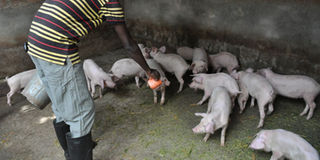Prime
City abattoir gets biogas plant

The project aims to benefit players along the value chain, including pig farmers. PHOTO BY RACHEL MABALA
What you need to know:
There are other connections to the biogas that are to be used for lighting as well
International Livestock Research Institute (ILRI) in partnership with Wambizzi Cooperative Society and Green Heat Uganda Ltd launched a biogas plant, which makes use of the pig waste and effluent from the Wambizzi abattoir in Nalukolongo, Kampala.
This is expected to improve waste management at Wambizzi, which is the only centralised abattoir in Uganda. The waste is converted into biogas for heating and lighting at the plant. Hitherto, it has been a challenge to efficiently dispose of the waste.
“We slaughter between 75-80 pigs a day. However, we do not have where to throw the intestines and the pig hair. Although some farmers take back some of it, we are still overwhelmed with pig waste,” says Thomas Kasule, treasurer of the cooperative society.
Construction of the plant was part of an ILRI project, called More Pork By and For the Poor, funded by Irish Aid to the tune of €395,000 (Shs1.29b) to improve food and nutrition security in the pig value chain.
Pezo Danilo, project leader, highlighted the challenge of managing waste. “The lack of sanitary control in slaughtering, processing and commercialisation of pork can result in food safety risks. However through the plant, we are controlling pollution and degradation of the environment,” he said.
“There are risks of cross contamination and to be able to reduce these risks, we are going to help in managing waste especially what is removed after slaughtering a pig. We want to reduce risks of contamination towards the pork so that from the farmer to the consumer, it is safe pork to eat,” explained Emily Ouma, the project coordinator.
At the plant, all waste from the slaughter house including dung, intestines and other entrails together with water are placed in a mixer. This goes through a process to produce biogas. Vianney Tumwesige, a researcher at Green Heat Uganda Ltd explains: “Part of the system stores the gas and the other manages the waste. With pipes underground, these are connected to stoves, which will be used for heating.” There are other connections to the biogas that are to be used for lighting as well.


